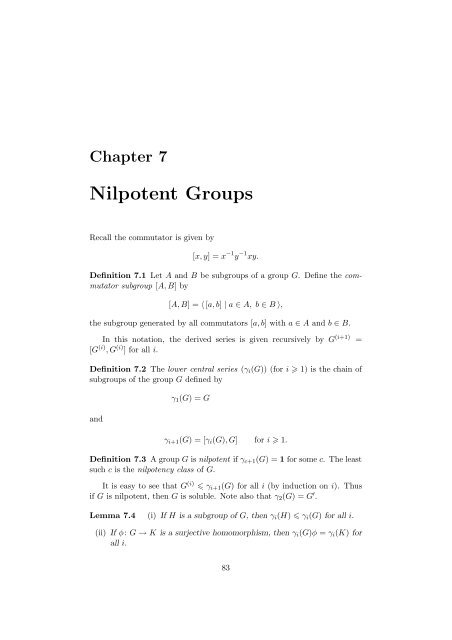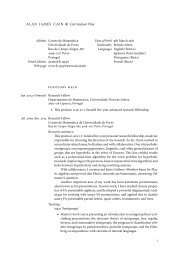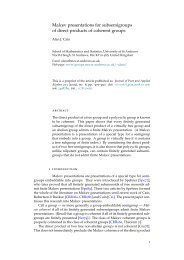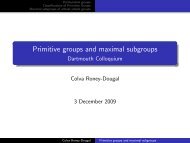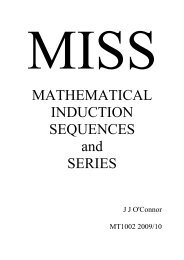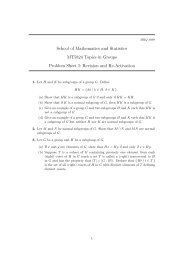Create successful ePaper yourself
Turn your PDF publications into a flip-book with our unique Google optimized e-Paper software.
Claim: P 1 P 2 ...P j∼ = P1 × P 2 ×···×P j for all j.Certainly this claim holds for j =1. Assumeitholdsforsomej, andconsider N = P 1 P 2 ...P j∼ = P1 ×···×P j G and P j+1 G. Then |N| iscoprime to |P j+1 |. Hence N ∩ P j+1 = 1 and therefore NP j+1 satisfies theconditions to be an (internal) direct product. ThusNP j+1∼ = N × Pj+1 ∼ = P1 × P 2 ×···×P j × P j+1 ,and by induction the claim holds.In particular, note|P 1 P 2 ...P k | = |P 1 × P 2 ×···×P k | = |P 1 |·|P 2 |·...·|P k | = |G|,soG = P 1 P 2 ...P k∼ = P1 × P 2 ×···×P k .(iii) ⇒ (i): Suppose G = P 1 ×P 2 ×···×P k ,adirectproductofnon-trivialp-groups. Then(by Corollary 2.41). ThenZ(G) =Z(P 1 ) × Z(P 2 ) ×···×Z(P k ) ≠ 1G/Z(G) =P 1 /Z(P 1 ) × P 2 /Z(P 2 ) ×···×P k /Z(P k )is a direct product of p-groups of smaller order. By induction, G/Z(G) isnilpotent, say γ c (G/Z(G)) = 1. Now apply Lemma 7.4(ii) to the naturalmap π : G → G/Z(G) toseethatγ c (G)π = γ c (G/Z(G)) = 1. Thusγ c (G) ker π =Z(G) andhenceγ c+1 (G) =[γ c (G),G] [Z(G),G]=1.Therefore G is nilpotent.□This tells us that the study of finite nilpotent groups reduces tounderstandingp-groups. We finish by introducing the Frattini subgroup, which isof significance in many parts of group theory.Definition 7.14 A maximal subgroup of a group G is a subgroup M
Lemma 7.15 Let G be a nilpotent group. Then every maximal subgroupof G is normal in G.□Definition 7.16 The Frattini subgroup Φ(G) ofagroupG is the intersectionof all its maximal subgroups:⋂Φ(G) = M.M maximalin G(If G is an (infinite) group with no maximal subgroups, then Φ(G) =G.)If we apply an automorphism to a maximal subgroup, we map it toanother maximal subgroup. Hence the automorphism group permutes themaximal subgroups of G.Lemma 7.17 If G is a group, then the Frattini subgroup Φ(G) is a characteristicsubgroup of G.□Our final theorem characterising nilpotent finite groups is:Theorem 7.18 Let G be a finite group. The following are equivalent:(i) G is nilpotent;(ii) H
(iv) ⇒ (v): Let P be a Sylow p-subgroup of G and let N = P Φ(G)(which is a subgroup of G, sinceΦ(G) G by Lemma 7.17). Let x ∈ Nand g ∈ G. Thenx −1 x g =[x, g] ∈ G ′ Φ(G) N.Hence x g ∈ N for all x ∈ N and g ∈ G, soN G. Now P is a Sylowp-subgroup of N (since it is the largest possible p-subgroup of G, so iscertainly largest amongst p-subgroups of N). Apply the Frattini Argument(Lemma 6.35):G =N G (P ) N=N G (P ) P Φ(G)=N G (P )Φ(G) (as P N G (P )).From this we deduce that G =N G (P ): for suppose N G (P ) ≠ G. ThenN G (P ) M < G for some maximal subgroup M of G. By definition,Φ(G) M, soN G (P )Φ(G) M
Thus S is a set of non-generators iffor all subsets X ⊆ G.G = 〈X, S〉 implies G = 〈X〉Lemma 7.21 The Frattini subgroup Φ(G) is a set of non-generators for afinite group G.Proof: Let G = 〈X, Φ(G)〉. If 〈X〉 ≠ G, then there exists a maximalsubgroup M of G such that 〈X〉 M


